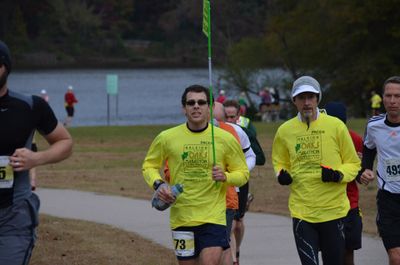Using a marathon pace group
1 Why use a pace group?
An organized pace group can help you achieve your marathon goal, as well as offering support and encouragement. The pacers can prevent you going out to fast, keep you steady for the middle miles, and then motivate you through to the end. This is just one way of Pacing Your Marathon.
2 Race Specific Notes
Each race is different, so find out the following information for your race.
- What pace groups will there be?
- How many pacers in each pace group? (Some races have one, some have many)
- How do you find your pacers at the start?
- How will you identify your pacers in the race? Tee shirt, balloons, etc?
- What is the course like? Is it flat or hilly? Where are the hills? (You need to know this anyway!)
3 Cautions
Most pace groups are led by experienced runners who can comfortably run the race at the specified time, and will keep you at just the right pace. However, I’ve heard of a few instances where the pacer starts too fast, trying to ‘bank time’. Check with the pacer what their strategy is, which should be an even effort run, aiming to cross the line no more than 2 minutes faster than target pace. Always check that the pacer is on pace and be prepared to do your own thing if necessary.
4 Tips for using a pace group
- You don't have to sign up to use a pace group, though doing so can help the organizers.
- Always introduce yourself to the pacers before the start of the race. Explain your goals and experience, and get to know your pacer.
- Typically, the pacers will have raced many marathons, but ask about their race strategy and previous experience pacing.
- On a hilly course, pacers will aim for an even effort, rather than an even pace. Doing the same pace up and down hills will make the race much harder. On courses with significant hills, this could be as much as a minute per mile faster downhill, and the same slower up hill.
- Don't expect your pacer to be exactly on time. A variation of 10-15 seconds per mile, even on the flat, is quite possible.
- A pace group will help you, but you need to be prepared for the race. Going out with a pace group that is too fast for you is no better than Going out too fast on your own.
- If you need to stop for any reason (toilet, retie a shoe, etc), aim to catch up your pacer slowly. Remember, it takes a lot more time to catch up than you expect. If you stop for 30 seconds, and pick up the pace by 10 seconds per mile, it will take you three miles to catch up!
- Make a note of the time you cross the start line. This is the difference between your chip time and the gun time.
- If you are running without a pace group and slow up at the end of the race, joining a pace group as they pass you is fine. They will be glad to help you out.
- Check if your pacer is intending to cross the line on target for the pace, or a minute or two faster. Are they intending to use gun time, or chip time?
- Find out what your pacer will do at Aid Stations; will the carry on at the same pace, slow down slightly, or walk through?
- Ask your pacer what their strategy is; it should be even effort, but check just in case.
- Ask your pacer about their background; have they paced this race before, what's their PR, how many marathons have they run/paced? These answers should give you confidence that your pacer is well prepared.
